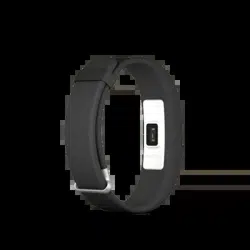Loading ...
Loading ...
Loading ...

Factors that affect pulse and stress measurement
Several factors can affect the performance of the SmartBand 2 heart rate sensor.
•
Skin perfusion: the amount of blood flowing through the skin varies significantly from
person to person and can also be impacted by the environment. If you’re exercising
in the cold, for example, the skin perfusion in your wrist may be too low for the heart
rate sensor to get a result.
•
Movement: rhythmic movements such as running or cycling give better results from
the heart rate sensor compared with irregular movements like in tennis or boxing.
•
Skin pigmentation variations: permanent or temporary changes to your skin, such as
some tattoos. The ink, pattern, and saturation of some tattoos can block light from
the sensor, making it difficult to get reliable results.
Getting the most from the SmartBand 2 heart rate sensor
Even under ideal conditions, the SmartBand 2 may not be able to get a reliable heart
rate reading every time for every individual. For a small percentage of users, various
factors may make it impossible to get any heart rate reading at all. Perform the
following steps if you want to improve the reading from the heart rate sensor:
•
Make sure that you wear your SmartBand 2 snugly, but comfortably on your wrist. If it
does not stay in place on your wrist and the heart rate sensor fails to get a good
reading, tighten the wristband.
•
You may need to clean the SmartBand 2, especially the heart rate sensor, after
exercising or heavy sweating.
Measuring pulse and stress automatically
The SmartBand 2 measures your pulse and stress and recovery level about six times
an hour.
Measuring pulse and stress manually
You can have your SmartBand 2 perform a reading of your pulse at any time, either
from the device itself or from your Android™ device.
To get the best heart rate data when exercising, initiate the heart rate sensor a few
minutes before your physical activity so that the sensor is able to detect your pulse.
Notifications,
except for incoming calls and alarms, are not passed to your SmartBand 2 when
you measure your pulse and stress manually.
To measure your pulse and stress manually from your SmartBand 2
1
To start measuring your pulse and stress level, double-press the power key.
The notification lights start to flash orange alternately and then together when
the reading is complete. The results are then displayed on the SmartBand 2
application on your iPhone.
2
To end the measurement, double-press the power key again.
If the SmartBand 2 cannot detect your pulse, it vibrates three times and the
notification lights
start to flash alternately in orange. If the heart rate sensor fails to get a reading, adjust the
SmartBand 2's position on your wrist or clean the sensor. For more information on improving
the reading from the heart rate sensor, see
Getting the most from the SmartBand 2 heart rate
sensor
on page 11.
To measure your pulse and stress manually from your Android™ device
1
From the main application screen of your Android™ device, find and tap
SmartBand 2. The SmartBand 2 immediately attempts to get a reading from
the heart rate sensor and displays the results on the Lifelog or SmartBand 2
application.
2
To end the measurement, quit the SmartBand 2 application.
11
This is an internet version of this publication. © Print only for private use.
Loading ...
Loading ...
Loading ...
